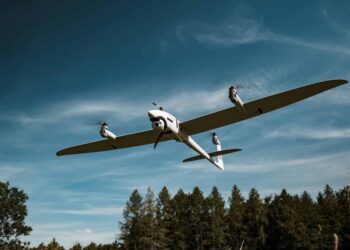AirLaunch LLC, KIRKLAND: AirLaunch LLC, DARPA and the Air Force made history yesterday as a simulated AirLaunch QuickReach rocket weighing 65,000 lbs was dropped out of a C-17A cargo aircraft, making it the heaviest single load to ever be dropped out of the plane.
“This was an important step for the program,” said Dr. Steven Walker of DARPA. “It expanded the envelope of C-17 air drop capabilities, and points the way toward a safe extraction technique for an affordable and responsive spacelift capability.”
The drop test was performed as part of a program that is exploring a new way of launching small satellites into space called the Falcon Small Launch Vehicle (SLV) program, administered by the U.S. Defense Advanced Research Projects Agency (DARPA) and the U.S. Air Force.
“This test is another accomplishment that will lead us to the next phase of the program and eventually to launch,” said Debra Facktor Lepore, president of AirLaunch LLC. “We are excited to be working with DARPA and the Air Force to develop new technologies that will enable operationally responsive access to space.”
The drop test and related activities were conducted at Edwards Air Force Base, Calif., by the Air Force Flight Test Center (AFFTC) 412th Test Wing and the 418th Flight Test Squadron in conjunction with the C-17 Systems Group of Wright Patterson Air Force Base, Ohio. The flight consisted of a 65,000 pound Drop Test Article (DTA), which simulates the QuickReach launch vehicle dropped from an unmodified C-17A aircraft at an altitude of 29,500 feet above Mean Sea Level (MSL) and a true airspeed of 330 knots. The aircraft used is on loan from Air Mobility Command to AFFTC.
“This drop test is the second in a series designed to assure that we can safely extract the QuickReach rocket from a C-17,” said Livingston Holder, AirLaunch's chief program executive. “With each test, we get closer to the actual mission launch altitude and launch vehicle weight, and ultimately developing a launch vehicle that meets the Falcon SLV requirements.”
The Falcon SLV program goal is to develop a vehicle that can launch a 1,000 pound satellite to Low Earth Orbit (LEO) for less than $5 million, within 24 hours of notice. Currently it costs about $20 million to launch a satellite of this size into space and the lead time can be months to years. Having a quick reaction launch system that can launch specialized small satellites will provide a new capability for both military and civil applications as well as stimulate commercial opportunities.
“The QuickReach rocket will enable the government to respond quickly when a military need arises or in response to a natural disaster by launching small remote sensing satellites on short notice,” said Holder.
AirLaunch's QuickReach rocket will carry small satellites into LEO. These satellites can be equipped with communication, camera and sensor payloads that allow special purpose support for military activities, hurricanes, and forest fires, as well as enable time-urgent communications in remote areas.
AirLaunch opted to launch its vehicle from a cargo aircraft at altitude to provide increased performance to take advantage of the efficiency of the innovative liquid oxygen and propane vapor pressurization (VAPAK) propulsion system that QuickReach(TM) employs. AirLaunch's approach also minimizes reliance on fixed launch ranges. NASA Wallops is contributing key range technology to this area of the program.
“Launching from the C-17 aircraft provides operational flexibility that becomes extremely important in matters of national security,” said Lepore. “The data from this drop test will provide us more information to develop this concept into a viable system for the United States.”
The team is in the second phase of the Falcon SLV contract or Phase 2B. As part of this phase, AirLaunch recently accomplished Milestone 3, which consisted of completed assembly of the payload fairing and additional engine test firings of its QuickReach stage two engine. AirLaunch previously conducted a stage separation test and two engine test fires as part of Phase 2B Milestones 1 and 2.
In 2005, Team AirLaunch completed Phase 2A on time and within budget with significant hardware development and testing. This included four engine test firings, a stage separation test, a ground drop test, and a C-17 drop test. At 65.8 feet, AirLaunch's DTA was the longest single object ever dropped from a C-17 aircraft, conducted on September 29, 2005. The flight test crew was nominated by Air Force Materiel Command (AFMC) for the 2005 Mackay Award, for the most Meritorious Air Force flight of the year. Phase 2A ground tests and the first air drop generated early data on propulsion, airframe, avionics and operations.
AirLaunch LLC is a small business headquartered in Kirkland, Washington.
Germany says adding explosive drones to weapons arsenal
Germany said Friday it would buy explosive drones for the first time as Berlin boosts investments in its armed forces...









